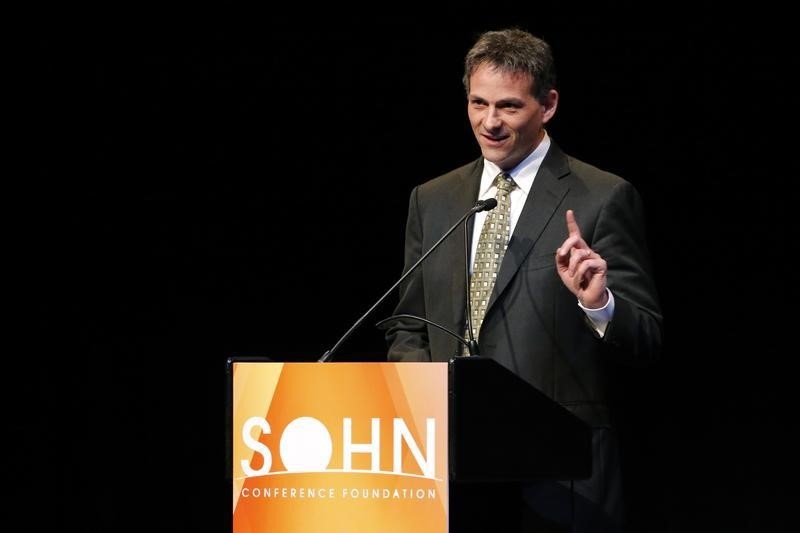By Svea Herbst-Bayliss
BOSTON (Reuters) - Superstar investor David Einhorn is raising cash for the first time since 2012 following three straight years of lagging performance - and some customer redemptions from his $10 billion (6.4 billion pounds) hedge fund, Greenlight Capital.
Einhorn has delivered an average 19 percent annual return over 18 years. But slower annual growth in the last years, plus the fund's restrictive redemption policies, have raised questions among some of his clients about Greenlight's prospects.
Einhorn's fund has returned 4.9 percent this year through October, compared with a 13 percent gain by the benchmark Standard & Poor's 500 Index. Similarly, he trailed the S&P 500 by 13 percentage points in 2013 and by 8 percentage points in 2012.
"We haven't had a quarter this thin in about three years," Einhorn wrote to investors regarding the recent third-quarter period. "We just got ground down gradually."
Some of Einhorn's short positions have weighed on performance this year, investors said. He recently closed out his short bet against Keurig Green Mountain Inc. with a loss. "We had many opportunities to trade this position to a successful result, but failed to do so," he wrote in the quarterly letter, which was seen by Reuters.
Also hurting performance: bets against U.S. Steel and Mallinckrodt and a bet on Marvel Technology Group Ltd, which lost 9 percent in the last six months.
While the average hedge fund returned only 3 percent this year, some of Einhorn's more direct competitors are doing better. William Ackman has posted a 35 percent return at his $18 billion Pershing Square Capital Management through the end of October, Ackman said in a letter to his investors.
Einhorn, Ackman, and Third Point's Daniel Loeb, who also has about $18 billion in assets, have long been seen as equally skilled by investors - and for a time the trio had a lot of overlap among clients.
One disadvantage for Einhorn going forward: he has more restrictive conditions than most other top-tier funds. No withdrawals are permitted for at least 25 months, and a 5 percent penalty is imposed on redemptions requested within three years, according to investors and documents reviewed by Reuters. After the lockup period expires, investors get only one chance a year to request an exit.
A spokesman for Greenlight declined to comment.
ASSET HUNTING
Greenlight last raised money in April 2012, when Einhorn accepted about $1.2 billion in new money, roughly half of what investors wanted to give him. That was designed to replace some redemptions that had occurred then - and also to boost the fund's capital by 10 percent, people familiar with the move said.
This year, all of Greenlight's capital was freed from lock up – with roughly half available for redemption by June 30, and the remainder by December 31, according to the sources and documents. The deadline to exit by year's end passed earlier in November.
STILL THE ONE
Despite some withdrawals detailed by investors contacted by Reuters, Greenlight remains an industry favourite with consultants. Investors have in the past lined up to give Einhorn money because of his track record – meaning the new fund raising effort could be oversubscribed as well.
Brian Shapiro, whose firm Simplify performs due diligence on hedge funds for wealthy clients, said Einhorn's reputation is still solid, calling his returns "reasonably consistent."
Einhorn made a name for himself in 2008 during the height of the financial crisis when his short bet against Lehman Brothers Holdings Inc added 7.3 percent to his returns that year. Even though Greenlight lost 23 percent in 2008, Einhorn fared better than other hedge funds which lost roughly 27 percent.
SECOND THOUGHTS?
The call against Lehman was considered bold and paid off when the bank filed for bankruptcy. But fast forward to 2014 and some investors said some recent picks look a little less interesting.
Greenlight's biggest position at the end of the third quarter was iPhone maker Apple, the company Goldman Sachs researchers say is the single most widely owned company among hedge funds.
In its October 16 letter soliciting fresh money, Greenlight said the fund had identified new investment ideas.
"While we have been fully invested for some time, it has been hard to find new opportunities. Given the current turmoil in the markets, this is changing quickly," the firm wrote.
Some of the new money is likely to come from people who already know and like Greenlight, industry analysts and investors said. They also said the money raising could follow the same pattern as two years ago where some replaces money that was redeemed and more is raised to deploy on new bets.
"Who will put money with Einhorn now?" Shapiro said. "People who buy brand name funds."
Greenlight's current investor line up includes pension funds, foundations and endowments which make up about one quarter of the assets, according to the documents. Funds of funds and high net worth investors also each make up about one quarter. The firm's partners and employees are also invested.
The last deadline to fund new investments was November 24 but the firm has not yet said how much new money it will accept. It couldn't be determined how much investors asked to get back at the two deadlines.

But this much is clear. Einhorn wants more money to cover some redemptions and make new investments to increase his hedge fund's returns. Said Simplify's Shapiro: "Einhorn has a lot of tail risk with some of his bigger bets and he needs to broaden his diversification which means he needs more cash."
(Reporting by Svea Herbst-Bayliss; Editing by Richard Valdmanis)